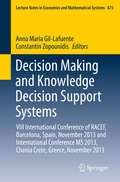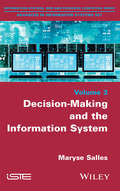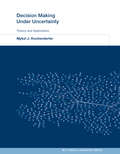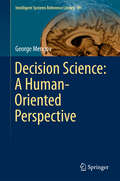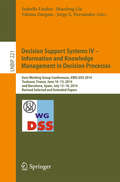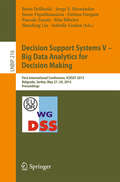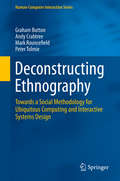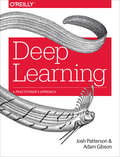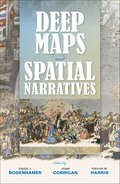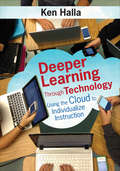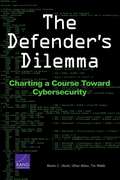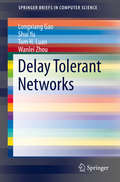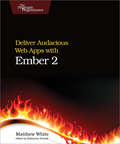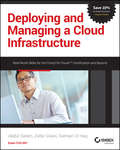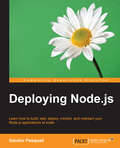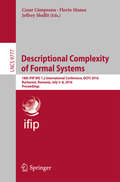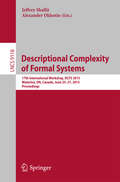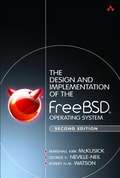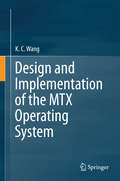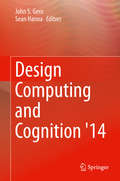- Table View
- List View
Decision Making and Knowledge Decision Support Systems
by Anna Maria Gil-Lafuente Constantin ZopounidisThis book presents recent advancements of research, new methods and techniques, applications and projects in decision making and decision support systems. It explores expert systems and neural networks, knowledge engineering and management, fuzzy sets and systems and computational methods for optimization, data analysis and decision making. It presents applications in Economics, Finance, Management and Engineering. The book undertakes to stimulate scientific exchange, ideas and experiences in the field of decision making in Economy and Management. Researchers and practitioners alike will benefit from this book, when they are dealing with imprecision, vagueness and uncertainty in the context of decision making.
Decision-Making and the Information System
by Maryse SallesThe purpose of this book is to question the relationships involved in decision making and the systems designed to support it: decision support systems (DSS). The focus is on how these systems are engineered; to stop and think about the questions to be asked throughout the engineering process and, in particular, about the impact designers' choices have on these systems.
Decision Making Under Uncertainty: Theory and Application (MIT Lincoln Laboratory Series)
by Mykel J. KochenderferAn introduction to decision making under uncertainty from a computational perspective, covering both theory and applications ranging from speech recognition to airborne collision avoidance.Many important problems involve decision making under uncertainty—that is, choosing actions based on often imperfect observations, with unknown outcomes. Designers of automated decision support systems must take into account the various sources of uncertainty while balancing the multiple objectives of the system. This book provides an introduction to the challenges of decision making under uncertainty from a computational perspective. It presents both the theory behind decision making models and algorithms and a collection of example applications that range from speech recognition to aircraft collision avoidance.Focusing on two methods for designing decision agents, planning and reinforcement learning, the book covers probabilistic models, introducing Bayesian networks as a graphical model that captures probabilistic relationships between variables; utility theory as a framework for understanding optimal decision making under uncertainty; Markov decision processes as a method for modeling sequential problems; model uncertainty; state uncertainty; and cooperative decision making involving multiple interacting agents. A series of applications shows how the theoretical concepts can be applied to systems for attribute-based person search, speech applications, collision avoidance, and unmanned aircraft persistent surveillance.Decision Making Under Uncertainty unifies research from different communities using consistent notation, and is accessible to students and researchers across engineering disciplines who have some prior exposure to probability theory and calculus. It can be used as a text for advanced undergraduate and graduate students in fields including computer science, aerospace and electrical engineering, and management science. It will also be a valuable professional reference for researchers in a variety of disciplines.
Decision Science: A Human-Oriented Perspective
by George MengovThis book offers a new perspective on human decision-making by comparing the established methods in decision science with innovative modelling at the level of neurons and neural interactions. The book presents a new generation of computer models, which can predict with astonishing accuracy individual economic choices when people make them by quick intuition rather than by effort. A vision for a new kind of social science is outlined, whereby neural models of emotion and cognition capture the dynamics of socioeconomic systems and virtual social networks. The exposition is approachable by experts as well as by advanced students. The author is an Associate Professor of Decision Science with a doctorate in Computational Neuroscience, and a former software consultant to banks in the City of London.
Decision Support Systems IV - Information and Knowledge Management in Decision Processes
by Isabelle Linden Shaofeng Liu Fátima Dargam Jorge E. HernándezThis book contains extended and revised versions of a set of selected papers from two events organized by the Euro Working Group on Decision Support Systems (EWG-DSS), which were held in Toulouse, France and Barcelona, Spain, in June and July 2014. Overall, 8 papers were accepted for publication in this edition after a rigorous review process through at least three internationally known experts from the EWG-DSS Program Committee and external invited reviewers. The selected papers focus on knowledge management and sharing, and on information models developed to support various decision processes.
Decision Support Systems IV - Information and Knowledge Management in Decision Processes: Euro Working Group Conferences, EWG-DSS 2014, Toulouse, France, June 10-13, 2014, and Barcelona, Spain, July 13-18, 2014, Revised Selected and Extended Papers (Lecture Notes in Business Information Processing #221)
by Jorge E. Hernández Fátima Dargam Shaofeng Liu Isabelle LindenThis book contains extended and revised versions of a set of selected papers from two events organized by the Euro Working Group on Decision Support Systems (EWG-DSS), which were held in Toulouse, France and Barcelona, Spain, in June and July 2014. Overall, 8 papers were accepted for publication in this edition after a rigorous review process through at least three internationally known experts from the EWG-DSS Program Committee and external invited reviewers. The selected papers focus on knowledge management and sharing, and on information models developed to support various decision processes.
Decision Support Systems V - Big Data Analytics for Decision Making
by Boris Delibašić Jorge E. Hernández Jason Papathanasiou Fátima Dargam Pascale Zaraté Rita Ribeiro Shaofeng Liu Isabelle LindenThis book constitutes the refereed proceedings of the First International Conference on Decision Support Systems Technology, ICDSST 2015, held in Belgrade, Serbia, in May 2015. The theme of the event was "Big Data Analytics for Decision-Making" and it was organized by the EURO (Association of European Operational Research Societies) working group of Decision Support Systems (EWG-DSS). The eight papers presented in this book were selected out of 26 submissions after being carefully reviewed by at least three internationally known experts from the ICDSST 2015 Program Committee and external invited reviewers. The selected papers are representative of current and relevant research activities in the area of decision support systems, such as decision analysis for enterprise systems and non-hierarchical networks, integrated solutions for decision support and knowledge management in distributed environments, decision support system evaluations and analysis through social networks, and decision support system applications in real-world environments. The volume is completed by an additional invited paper on big data decision-making use cases.
Deconstructing Ethnography
by Graham Button Andy Crabtree Mark Rouncefield Peter TolmieThis book aims to deconstruct ethnography to alert systems designers, and other stakeholders, to the issues presented by new approaches that move beyond the studies of 'work' and 'work practice' within the social sciences (in particular anthropology and sociology). The theoretical and methodological apparatus of the social sciences distort the social and cultural world as lived in and understood by ordinary members, whose common-sense understandings shape the actual milieu into which systems are placed and used. In Deconstructing Ethnography the authors show how 'new' calls are returning systems design to 'old' and problematic ways of understanding the social. They argue that systems design can be appropriately grounded in the social through the ordinary methods that members use to order their actions and interactions. This work is written for post-graduate students and researchers alike, as well as design practitioners who have an interest in bringing the social to bear on design in a systematic rather than a piecemeal way. This is not a 'how to' book, but instead elaborates the foundations upon which the social can be systematically built into the design of ubiquitous and interactive systems.
Deep Learning: A Practitioner's Approach
by Adam Gibson Josh PattersonAlthough interest in machine learning has reached a high point, lofty expectations often scuttle projects before they get very far. How can machine learning—especially deep neural networks—make a real difference in your organization? This hands-on guide not only provides the most practical information available on the subject, but also helps you get started building efficient deep learning networks.Authors Adam Gibson and Josh Patterson provide theory on deep learning before introducing their open-source Deeplearning4j (DL4J) library for developing production-class workflows. Through real-world examples, you’ll learn methods and strategies for training deep network architectures and running deep learning workflows on Spark and Hadoop with DL4J.Dive into machine learning concepts in general, as well as deep learning in particularUnderstand how deep networks evolved from neural network fundamentalsExplore the major deep network architectures, including Convolutional and RecurrentLearn how to map specific deep networks to the right problemWalk through the fundamentals of tuning general neural networks and specific deep network architecturesUse vectorization techniques for different data types with DataVec, DL4J’s workflow toolLearn how to use DL4J natively on Spark and Hadoop
Deep Maps and Spatial Narratives (The Spatial Humanities)
by John Corrigan David J. Bodenhamer Trevor M. HarrisDeep maps are finely detailed, multimedia depictions of a place and the people, buildings, objects, flora, and fauna that exist within it and which are inseparable from the activities of everyday life. These depictions may encompass the beliefs, desires, hopes, and fears of residents and help show what ties one place to another. A deep map is a way to engage evidence within its spatio-temporal context and to provide a platform for a spatially-embedded argument. The essays in this book investigate deep mapping and the spatial narratives that stem from it. The authors come from a variety of disciplines: history, religious studies, geography and geographic information science, and computer science. Each applies the concepts of space, time, and place to problems central to an understanding of society and culture, employing deep maps to reveal the confluence of actions and evidence and to trace paths of intellectual exploration by making use of a new creative space that is visual, structurally open, multi-media, and multi-layered.
Deeper Learning Through Technology: Using the Cloud to Individualize Instruction
by Mr Kenneth P. HallaUse the Cloud to Individualize Your Instruction and Watch Your Students Thrive! Cloud-based technology offers massive benefits to the classroom. But technology tools require conscientious implementation by educators. This book is the all-in-one resource you need to be sure your students reap the fullest rewards of how cloud-based tools can facilitate learning. In Deeper Learning Through Technology, teacher and top ed-blogger Ken Halla explains: How to implement new tech tools to create a self-paced, learner-centered classroom Strategies for leveraging cloud technology to ensure that students have access to an individualized, personalized education Real-life case studies and activities that will make applying the book’s strategies to your classroom enjoyable and achievable
Deeper Learning Through Technology: Using the Cloud to Individualize Instruction
by Mr Kenneth P. HallaUse the Cloud to Individualize Your Instruction and Watch Your Students Thrive! Cloud-based technology offers massive benefits to the classroom. But technology tools require conscientious implementation by educators. This book is the all-in-one resource you need to be sure your students reap the fullest rewards of how cloud-based tools can facilitate learning. In Deeper Learning Through Technology, teacher and top ed-blogger Ken Halla explains: How to implement new tech tools to create a self-paced, learner-centered classroom Strategies for leveraging cloud technology to ensure that students have access to an individualized, personalized education Real-life case studies and activities that will make applying the book’s strategies to your classroom enjoyable and achievable
Deeper Learning Through Technology: Using the Cloud to Individualize Instruction
by Mr. Kenneth P. HallaUse the Cloud to Individualize Your Instruction and Watch Your Students Thrive! Cloud-based technology offers massive benefits to the classroom. But technology tools require conscientious implementation by educators. This book is the all-in-one resource you need to be sure your students reap the fullest rewards of how cloud-based tools can facilitate learning. In Deeper Learning Through Technology, teacher and top ed-blogger Ken Halla explains: How to implement new tech tools to create a self-paced, learner-centered classroom Strategies for leveraging cloud technology to ensure that students have access to an individualized, personalized education Real-life case studies and activities that will make applying the book’s strategies to your classroom enjoyable and achievable
Deeper Learning Through Technology: Using the Cloud to Individualize Instruction
by Mr. Kenneth P. HallaUse the Cloud to Individualize Your Instruction and Watch Your Students Thrive! Cloud-based technology offers massive benefits to the classroom. But technology tools require conscientious implementation by educators. This book is the all-in-one resource you need to be sure your students reap the fullest rewards of how cloud-based tools can facilitate learning. In Deeper Learning Through Technology, teacher and top ed-blogger Ken Halla explains: How to implement new tech tools to create a self-paced, learner-centered classroom Strategies for leveraging cloud technology to ensure that students have access to an individualized, personalized education Real-life case studies and activities that will make applying the book’s strategies to your classroom enjoyable and achievable
The Defender's Dilemma: Charting a Course Toward Cybersecurity
by Martin C. Libicki Lillian Ablon Tim WebbCybersecurity is a constant, and, by all accounts growing, challenge. This report, the second in a multiphase study on the future of cybersecurity, reveals perspectives and perceptions from chief information security officers; examines the development of network defense measures and the countermeasures that attackers create to subvert those measures; and explores the role of software vulnerabilities and inherent weaknesses. "
Delay Tolerant Networks
by Longxiang Gao Shui Yu Tom H. Luan Wanlei ZhouThis brief presents emerging and promising communication methods for network reliability via delay tolerant networks (DTNs). Different from traditional networks, DTNs possess unique features, such as long latency and unstable network topology. As a result, DTNs can be widely applied to critical applications, such as space communications, disaster rescue, and battlefield communications. The brief provides a complete investigation of DTNs and their current applications, from an overview to the latest development in the area. The core issue of data forward in DTNs is tackled, including the importance of social characteristics, which is an essential feature if the mobile devices are used for human communication. Security and privacy issues in DTNs are discussed, and future work is also discussed.
Deliver Audacious Web Apps with Ember 2
by Matthew WhiteIt's time for web development to be fun again, time to write engaging and attractive apps--fast--in this brisk tutorial. Build a complete user interface in a few lines of code, create reusable web components, access RESTful services and cache the results for performance, and use JavaScript modules to bring abstraction to your code. Find out how you can get your crucial app infrastructure up and running quickly, so you can spend your time on the stuff great apps are made of: features.With its 2.0 release, the Ember JavaScript framework has taken a major step forward. In this book, you'll learn these new features: how to use module-driven development with Ember CLI, take advantage of the new DOM-based rendering engine, and use a service-based architecture to make your apps flexible, not brittle.Use the Ember CLI to build your app using module-focused JavaScript classes with a clear project structure. Learn how to use Ember's routing classes to organize your app, write web components that marry your user interface and logic without leaky access to state, and read and write data from RESTful services with almost no code. Make use of services to encapsulate logic and inject it throughout your app, and use Ember CLI to rapidly iterate changes, deploy locally, test your code, and build for production. You'll learn all the essentials of working with Ember.If you're tired of feeling limited by your web development tools, unleash your ambition and start creating ambitious web applications with Ember.What You Need:You need Ember, Ember CLI, Google Chrome or Mozilla Firefox, and a text editor.
Deploying and Managing a Cloud Infrastructure
by Salman Ul Haq Abdul Salam Zafar GilaniLearn in-demand cloud computing skills from industry expertsDeploying and Managing a Cloud Infrastructure is an excellent resource for IT professionals seeking to tap into the demand for cloud administrators. This book helps prepare candidates for the CompTIA Cloud+ Certification (CV0-001) cloud computing certification exam. Designed for IT professionals with 2-3 years of networking experience, this certification provides validation of your cloud infrastructure knowledge.With over 30 years of combined experience in cloud computing, the author team provides the latest expert perspectives on enterprise-level mobile computing, and covers the most essential topics for building and maintaining cloud-based systems, including:Understanding basic cloud-related computing concepts, terminology, and characteristicsIdentifying cloud delivery solutions and deploying new infrastructureManaging cloud technologies, services, and networksMonitoring hardware and software performanceFeaturing real-world examples and interactive exercises, Deploying and Managing Cloud Infrastructure delivers practical knowledge you can apply immediately. And, in addition, you also get access to a full set of electronic study tools including:Interactive Test EnvironmentElectronic FlashcardsGlossary of Key TermsNow is the time to learn the cloud computing skills you need to take that next step in your IT career.
Deploying Node.js
by Sandro PasqualiIf you are an intermediate or advanced developer deploying your Node.js applications, then this book is for you. If you have already built a Node application or module and want to take your knowledge to the next level, this book will help you find your way.
Descriptional Complexity of Formal Systems
by Cezar Câmpeanu Florin Manea Jeffrey ShallitThis book constitutes the refereed proceedings of the 17th International Conference on Descriptional Complexity of Formal Systems, DCFS 2015, held in Waterloo, ON, Canada, in June 2015. The 23 full papers presented together with 2 invited talks were carefully reviewed and selected from 29 submissions. The subject of the workshop was descriptional complexity. Roughly speaking, this field is concerned with the size of objects in various mathematical models of computation, such as finite automata, pushdown automata, and Turing machines. Descriptional complexity serves as a theoretical representation of physical realizations, such as the engineering complexity of computer software and hardware. It also models similar complexity phenomena in other areas of computer science, including unconventional computing and bioinformatics.
Descriptional Complexity of Formal Systems
by Jeffrey Shallit Alexander OkhotinThis book constitutes the refereed proceedings of the 17th International Conference on Descriptional Complexity of Formal Systems, DCFS 2015, held in Waterloo, ON, Canada, in June 2015. The 23 full papers presented together with 2 invited talks were carefully reviewed and selected from 29 submissions. The subject of the workshop was descriptional complexity. Roughly speaking, this field is concerned with the size of objects in various mathematical models of computation, such as finite automata, pushdown automata, and Turing machines. Descriptional complexity serves as a theoretical representation of physical realizations, such as the engineering complexity of computer software and hardware. It also models similar complexity phenomena in other areas of computer science, including unconventional computing and bioinformatics.
Design and Development of Training Games
by Talib S. Hussain Susan L. ColemanThe multidisciplinary nature of learning-games development is key to successful projects. In this book, field leaders in serious games and professionals in entertainment games share practical guidelines and lessons from their own experiences researching and developing learning games. This volume includes: • The key elements of design and development that require particular attention from multiple disciplines to ensure success • An overview of successful models and methods, and the trade-offs made throughout the process, to guide development • Cohesive, multidisciplinary views of the issues that arise and of the techniques applied in order to produce effective learning games grounded in specific experiences, community consensus, and analysis of successful learning games that have already been released • The stories behind the games, to illustrate how final design and development decisions were reached. Aimed at professionals and academics interested in developing and researching learning games, it offers a comprehensive picture of the state of the art.
The Design and Implementation of the FreeBSD Operating System
by Marshall Kirk Mckusick George V. Neville-Neil Robert N.M. WatsonThis technical guide to FreeBSD's internal structure has now been extensively updated to cover all major improvements between Versions 5 and Version 11.
Design and Implementation of the MTX Operating System
by K. C. WangThis course-tested textbook describes the design and implementation of operating systems, and applies it to the MTX operating system, a Unix-like system designed for Intel x86 based PCs. Written in an evolutional style, theoretical and practical aspects of operating systems are presented as the design and implementation of a complete operating system is demonstrated. Throughout the text, complete source code and working sample systems are used to exhibit the techniques discussed. The book contains many new materials on the design and use of parallel algorithms in SMP. Complete coverage on booting an operating system is included, as well as, extending the process model to implement threads support in the MTX kernel, an init program for system startup and a sh program for executing user commands. Intended for technically oriented operating systems courses that emphasize both theory and practice, the book is also suitable for self-study.
Design Computing and Cognition '14
by John S. Gero Sean HannaThis book details the state-of-the-art of research and development in design computing and design cognition. It features more than 35 papers that were presented at the Sixth International Conference on Design Computing and Cognition, DCC'14, held at University College, London, UK. Inside, readers will find the work of expert researchers and practitioners that explores both advances in theory and application as well as demonstrates the depth and breadth of design computing and design cognition. This interdisciplinary coverage, which includes material from international research groups, examines design synthesis, design cognition, design creativity, design processes, design theory, design grammars, design support and design ideation. Overall, the papers provide a bridge between design computing and design cognition. The confluence of these two fields continues to build the foundation for further advances and leads to an increased understanding of design as an activity whose influence continues to spread. As a result, the book will be of particular interest to researchers, developers and users of advanced computation in design and those who need to gain a better understanding of designing that can be obtained through empirical studies.
